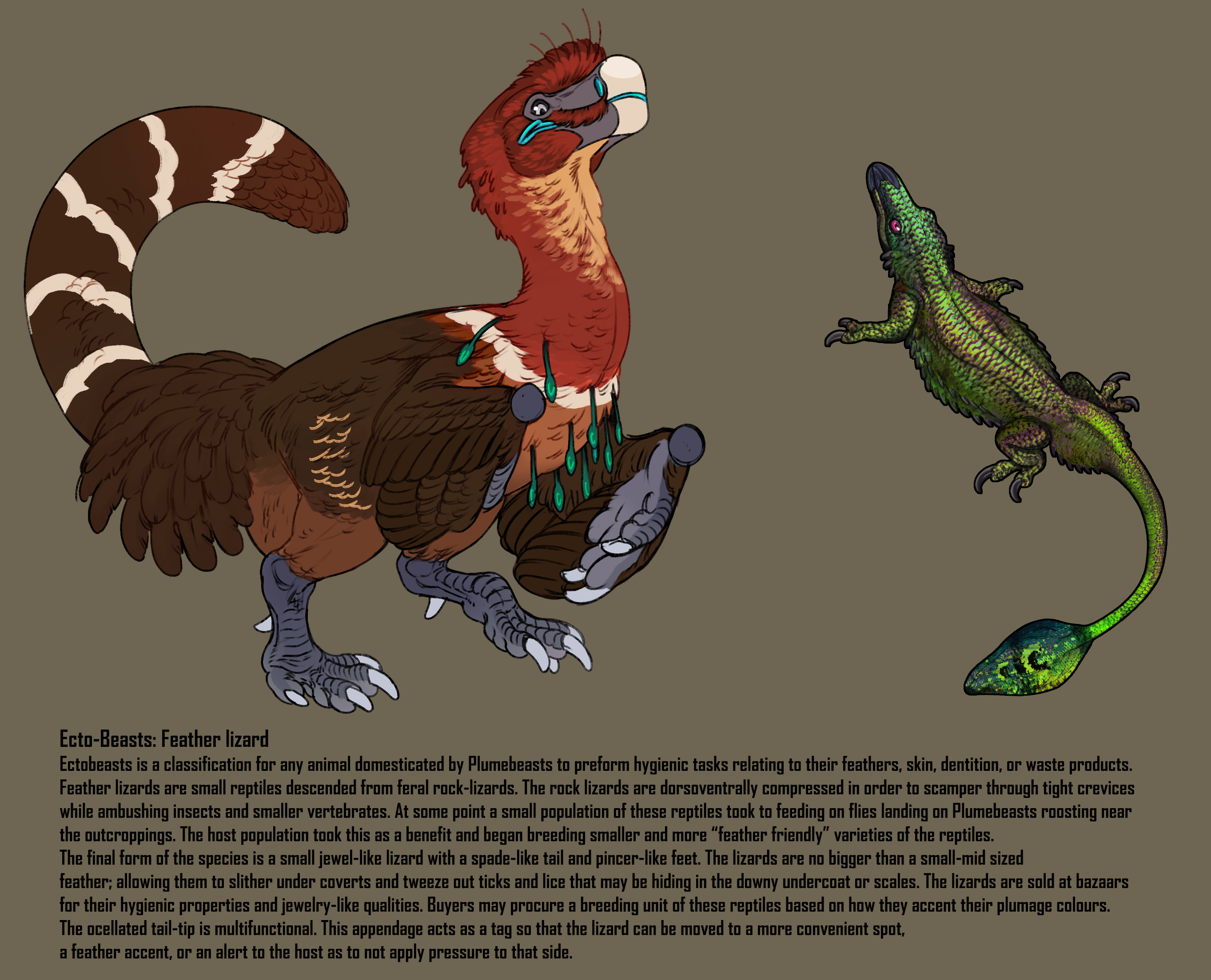Ecto Beasts: Feather lizards
Thracus sunned himself on a boulder outside of his den. With his head knocked back and eyes half closed, he took in the morning air and climbing sun. His Mantle and scapularies spread revealing the apterium (bald tracts) on the small of his back.
A large biting fly lands on his cheek. A small beak flashes out of his nape plumes and plucks a morning fly of his face. The feathers of his shoulders rustled, and two small green spades crawled from beneath them and made their way to the warming patch on Thracus's back.
didactyl feet flared from either side of the small iridescent green animal's dorso-ventrally compressed body. Flowing down to their long antennae-like tails bloomed a spade complete with a gorgeous eyespot.
As the lizards accumulate on Thracus's dorsal side the number of flying insects is visually reduced by their activity.
Basic Information
Anatomy
The reptiles have traded in reptilian lips fora keratinous beak used to tweeze ectoparasites out of their host's hide. Feather lizards have a dorso-ventrally compressed body. small, pointed scales radiate along the lateral line of the lizard. These projections make it difficult for the lizard to be swallowed by another animal, but also allows them to affix themselves to downy feathers.
All 4 feet end in two toes that can latch downwards or oppose each other like pincers.
The Lizards have a long thin tail that ends in a spatulate tip. This tip usually is decorated with an eyespot, but may otherwise have a stripe, streak, radiation, etc.
Genetics and Reproduction
Feather lizards are a social species of lizard. The dominant pair produces a clutch of self-adhesive eggs that is placed in a crevice or burrow near a host-roosting site.
Eggs hatch in 38-70days (temp dependent). Young hatch out capable of boarding their host and feeding themselves.
Additional Information
Social Structure
Feather lizards tend to crop up in family units consisting of a mated pair and their progeny.
Domestication
Ectobeasts is a classification for any animal domesticated by Plumebeasts to preform hygienic tasks relating to their feathers, skin, dentition, or waste products.
Feather lizards are small reptiles descended from feral rock-lizards. The rock lizards are dorsoventrally compressed in order to scamper through tight crevices
while ambushing insects and smaller vertebrates. At some point a small population of these reptiles took to feeding on flies landing on Plumebeasts roosting near
the outcroppings. The host population took this as a benefit and began breeding smaller and more “feather friendly” varieties of the reptiles.
The final form of the species is a small jewel-like lizard with a spade-like tail and pincer-like feet. The lizards are no bigger than a small-mid sized
feather; allowing them to slither under coverts and tweeze out ticks and lice that may be hiding in the downy undercoat or scales. The lizards are sold at bazaars
for their hygienic properties and jewelry-like qualities. Buyers may procure a breeding unit of these reptiles based on how they accent their plumage colours.
The ocellated tail-tip is multifunctional. This appendage acts as a tag so that the lizard can be moved to a more convenient spot,
a feather accent, or an alert to the host as to not apply pressure to that side.
Average Intelligence
No smarter than the standard gecko
Lifespan
1-3 years in optimal conditions
Average Length
3-6 inches depending on breed and age.
Body Tint, Colouring and Marking
Feather lizards come in a wide range of colours and patterns. Selective breeding has been devoted to both their hygienic function and their jewel like appearance. Specimens come in brown, red, green, blue, yellow, black and pearl. Less appealing morphs have a lower trade value at the bazaars.




